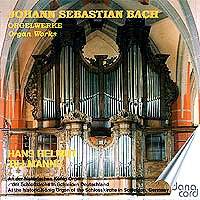It now seems that after
Bach’s death his music was not entirely
forgotten until the blessed days of
Felix Mendelssohn; this story is actually
a touch of musical spin because of Mendelssohn’s
own rich association with St. Thomas’s
Leipzig. In fact Bach’s organ works
continued in the repertoire well into
the 19th century and were
in print. Works like the ones recorded
here are examples of good standard Bachian
repertoire.
Hans Helmut Tillmans
will be well known to those who have
been collecting the complete works on
Danacord as this is now volume nine.
He has also recorded Buxtehude and some
rare Italian music of the 18th
century. His biography tells us that
he is also familiar with contemporary
music although gives us no names of
composers with whom he has been associated.
The CD booklet is a
very curious object and I should mention
it now. It is adorned with a photo of
the fine case of the organ at the Schlosskirke
in Schleiden. On the back in colour
is a rather glum looking Hans Tillmanns
in an unflattering pose with a brief
biography. Inside there is brief note
on Bach’s early career, reminding us
that his first appointment was in 1703
in Arnstadt and that many of his best
organ works were composed early on in
his career when he was already writing
in a variety of musical forms and was
influenced by his contemporaries both
German and Italian. Then there is a
more substantial note on the organ which
adorns the cover. The specification
of both instruments is given. There
is a note whimsically entitled ‘Company
news’ which informs us about the Weimbs
family who are responsible for the restoration
of the historic organ in Koln-Widdersdorf.
Finally comes the only musical comment
which deals succinctly with the Eight
short Preludes and Fugues BWV 553-60
which are almost certainly not by Bach
anyway but by one of his pupils! The
disc also informs us that the length
of the CD is 61.36. Its actual length
is less than an hour and nowadays this
seems to be a little under par.
Putting these cavils
to one side and concentrating on the
music and on the performance is mercifully
easier and a pleasant task. I can report
only positive things. The acoustic of
the churches is nicely captured but
does not interfere. The organs are realistically
recorded. It is of interest to compare
them.
The smaller organ is
the one at Koln-Widdersdorf. It has
two manuals and sixteen stops including
a charming two foot ‘Flageolet’. It
is used only for the ‘Eight short Preludes
and Fugues’. It is a pity that it is
only used for these short-winded pieces
and not for a couple of choral preludes
as well> It is well suited to these
pieces and as I have said, there is
ample space on the CD. Its lighter touch
is ideal here.
The old town of Schleiden
was largely destroyed in the Second
World War but remarkably the church
built on the periphery of the town survived.
The organ at the Schlosskirche has two
manuals but thirty stops including no
less than seven for the pedal board.
Its original builder is anonymous but
Tillmanns suggests that it was probably
Christian König c.1770 the façade
of his instrument as well as several
stops survives from that time although
much restoration has been carried out
since, most recently in 1988, when the
pedal board was enlarged. Frustratingly
no history is given for the Koln-Widdersdorf
organ by Weimbs.
Some musical highlights:
I find the performances sure and faultless.
The opening Fantaisie in C minor sets
the tone with a solemn tread yet bright
registration with eight-foot flute stops
on the Great. The famous Fugue in G
minor is played with dexterity and clarity
and with a clever build-up of registration.
And the memorable Fugue based on a theme
from Corelli’s Op 3, shows Bach’s indebtedness
and interest in contemporary Italian
developments.
Gary Higginson
